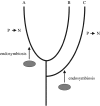The origin of plastids
- PMID: 18468982
- PMCID: PMC2606771
- DOI: 10.1098/rstb.2008.0050
The origin of plastids
Abstract
It is generally accepted that plastids first arose by acquisition of photosynthetic prokaryotic endosymbionts by non-photosynthetic eukaryotic hosts. It is also accepted that photosynthetic eukaryotes were acquired on several occasions as endosymbionts by non-photosynthetic eukaryote hosts to form secondary plastids. In some lineages, secondary plastids were lost and new symbionts were acquired, to form tertiary plastids. Most recent work has been interpreted to indicate that primary plastids arose only once, referred to as a 'monophyletic' origin. We critically assess the evidence for this. We argue that the combination of Ockham's razor and poor taxon sampling will bias studies in favour of monophyly. We discuss possible concerns in phylogenetic reconstruction from sequence data. We argue that improved understanding of lineage-specific substitution processes is needed to assess the reliability of sequence-based trees. Improved understanding of the timing of the radiation of present-day cyanobacteria is also needed. We suggest that acquisition of plastids is better described as the result of a process rather than something occurring at a discrete time, and describe the 'shopping bag' model of plastid origin. We argue that dinoflagellates and other lineages provide evidence in support of this.
Figures




References
-
- Aldridge C, Maple J, Møeller S.G. The molecular biology of plastid division in higher plants. J. Exp. Bot. 2005;56:1061–1077. doi:10.1093/jxb/eri118 - DOI - PubMed
-
- Allen J.F. The function of genomes in bioenergetic organelles. Phil. Trans. R. Soc. B. 2003;358:19–37. doi:10.1098/rstb.2002.1191 - DOI - PMC - PubMed
-
- Archibald J.M, Rogers M.B, Toop M, Ishida K.-I, Keeling P.J. Lateral gene transfer and the evolution of plastid-targeted proteins in the secondary plastid-containing alga Bigelowiella natans. Proc. Natl Acad. Sci. USA. 2003;100:7678–7683. doi:10.1073/pnas.1230951100 - DOI - PMC - PubMed
-
- Armbrust E.V, et al. The genome of the diatom Thalassiosira pseudonana: ecology, evolution, and metabolism. Science. 2004;306:79–86. doi:10.1126/science.1101156 - DOI - PubMed
-
- Barbrook A.C, Howe C.J. Minicircular plastid DNA in the dinoflagellate Amphidinium operculatum. Mol. Gen. Genet. 2000;263:152–158. doi:10.1007/s004380050042 - DOI - PubMed
Publication types
MeSH terms
Substances
Grants and funding
LinkOut - more resources
Full Text Sources

